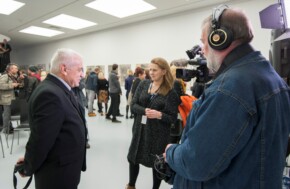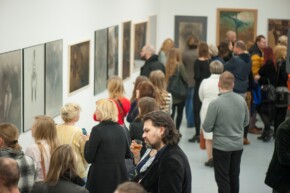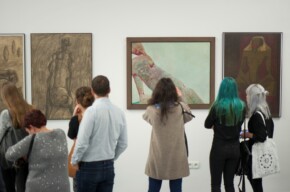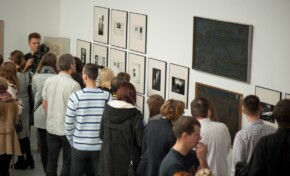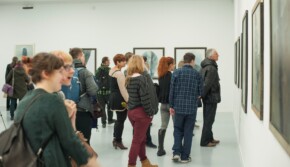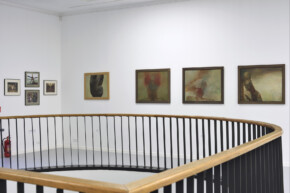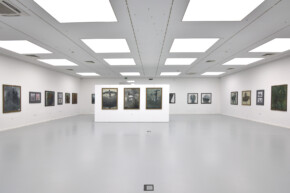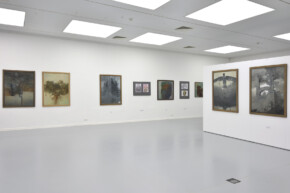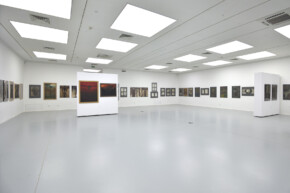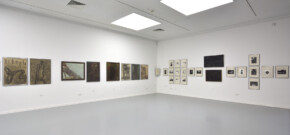In a letter to a young lover of the art, dated on June 4th, 1965, Beksiński wrote down the thoughts to which he remained faithful all his life. He never created a theory, but quite often he tried to explain to others not so much what art is, as what it is not for him. Half a century later, it is worth to ponder these reflections again: In painting, it often happens that you plan one thing, and halfway through the work you get attracted to another, as the first vision fades and that which is already partially done begins suggesting another solution, which seems more attractive than the one you thought in the beginning. (…) When I started my career, I had the habit of persistently sticking to the original concept and I pushed away all the departures from that concept like a monk pushes away impure thoughts. I have found that it’s possible to finish a picture this way, but neither the picture will benefit from it, nor the audience will like the picture, as working on it is torturous, against one’s will and in spite of oneself.
Nowadays, I set about painting often having a very vague concept, and only when working the ideas of solutions start dawning on me, etc. It’s amusing, because I am not bored. The process of inventing is broken into stages, I invent only as much as I manage to before I get bored. (…) Going back to what I wrote above, I think that it is irrelevant whether the creation process takes place before work or during work. One way or the other, it takes a certain number of time units, and this is probably quite unimportant whether it takes longer or shorter. The point is that art should really be some kind of a spiritual orgasm, something that happens from minute to minute, not a technical realisation of something that already happened earlier or even a week before and had time burn itself out. Naturally, there are techniques that do not allow such freedom. (…) But drawing is a technique of improvisation. You don’t go back to anything, don’t plan anything, the mood changes while working, work grows bigger, oh my, drawing is the best of everything! The reason I hated architecture so much was that architecture is planning, designing, and realisation dry as dust. (…) Now, as for the “macabre. That’s right! All my friends always see macabre in my drawings. If only they looked around themselves they’d notice much more of it and more explicit, at that. My drawings are mostly grotesque, I want them to be strange and disturbing. Mystery, transcendence, inexplicable things, woolliness of all sorts are things that give me a thrill of excitement. I can’t help it. (…) It seems to me that beauty lies precisely in part in mystery, that when we get rid of mystery and attempt to break everything down into parts, as model teacher of Polish does with a poem by Tuwim, then it’ll turn out badly for us, as all the beauty will go to hell. (…) And I think art expresses astonishment with the world, fear of the incomprehensible, of the incredible disparity of infinity and man (…).
Writing these words, he had already achieved quite varied things, but the most important thing visional painting was still ahead of him. However, he expressed this astonishment with the world, the fear of the incomprehensible already in his earliest attempts at art.
And what was in the beginning? Since his childhood, he wouldn’t be parted from pencils. What he drew then, was characteristic for the childhood or youthful period. There were patriotic, lofty motifs there or during the war air battles, tanks and soldiers. With time, he started drawing landscapes and portraits, increasingly mature in execution. Ultimately, he gathered a portfolio of works that he could take to the entrance exam at the Krakow Academy of Fine Arts. And he would be admitted there (even though he himself dreamt of directing at film school), but his father decided for him he must be an architect, because the country is destroyed, and he would have to provide for himself and his family. He studied at the Krakow Polytechnic without any special commitment and no achievements. What really gave him pleasure then, were concerts at the Philharmonic. He’d always loved music. He began to compensate his dreams of movie making with photography. The first pictures of an artistic nature already show a variety of pursuits. So we see some pseudo-documentaries with anonymous people wandering the empty streets of Krakow, but also some fragments of architecture photographed so as to build an almost abstract design with distinctive rhythms. During his studies he met his future wife Zofia Stankiewicz. This big love, which lasted until her death, had also become the inspiration for photography. It was his wife who was the main model allowing him to realise a variety of ideas. Early photographs, full of admiration for the beauty of the model, helped him master the workshop and look for different techniques.
In the technique we can see his sensitivity to light, almost impressionistic atmosphere full of cheerfulness, not to say joy. But the most important works were created only after his return to Sanok in 1955. They’re dominated by the topics of transience, decay and destruction.
In my youth, I thought (one of the ideas) of this short film, in which the world, begins to materially fall apart before the eyes of some old lady: air is going out of the tires, glass is falling out from the windows, plaster is flaking from the walls, but then the walls themselves fall apart, and finally you can only see the moving waves of the ocean of debris (there was no computer animation, so I planned to do it with bulldozers), and only that old lady is left, and in the mist of dust walks around a little pointlessly, staring with unseeing eyes. The environment and the world are constantly destroyed before our eyes, but because in place of the crumbling the new constantly grows, it seems to us that nothing changes, and only at some point we notice that the destruction applies to us as well.
He couldn’t make the movie, but his photographic ideas are characterised by such atmosphere. On an empty square, from which almost all the details disappeared in contrast of black and white, we can see an old woman leaving the frame, cut off with the edge of the photo. In another picture, he put together an old woman’s face furrowed with wrinkles with a smooth face of a baby. Similar threads appeared in the early drawings lonely people, prisons, interrogations, old age and death. When he created these works, he didn’t know he was going to be an artist he simply had to let out all these things that his imagination suggested. Almost in parallel with the mature photography and still not very mature, but very rich collection of drawings, he started flirting with the contemporary abstractionism, a trend which in the 1950s and 1960s dominated in the art world. It was then that he created a whole cycle of images-reliefs with imposing layers of plaster and paint, sculpts the surfaces, creates splinters and mounts metal sheets welding them or soldering. He obtains extremely rich and at the same time very beautiful materials.
In 1959, Jacek Woźniakowski wrote about the reliefs he saw, in a poetic and incisive way: The material of one of the Beksiński’s images looks like old, noble, subdued pottery, but especially the second picture got my attention: a rectangle of almost black, matte-like, worm-eaten wood in places slightly iridescent, which again resembles a velvety surface of charred, cracked log. But one could compare this modulation of small, almost geometric strings to some burnt-out city viewed from a great distance or to the logic of the logic of the geological erosion. Comparisons here are quite unimportant, because Beksiński’s art works not so much through this type of allusions, but through their sum, or rather through the aura in which they are conceived: it has a delicate and constantly variable regularity of nature’s creation, simplicity and sophistication of the things the faces of which were slowly and stately sculpted by time, which destroyed their original shape but gave them at the same time an existence that is more resilient or maybe tragically dead? (J. Woźniakowski, Co się dzieje ze sztuką?(What is going on with art?), PIW no edition data, pp. 183-184).
This period of the late 1950s and the 1960s was extremely fruitful in ideas and works. He worked in the Autosan factory in Sanok, where he designed several bodies of buses, carries an extremely lively correspondence with many people. creates reliefs and sculptures. In the last phase of photography work (1958-59) he was ahead of conceptualism with his boards combining photographs (not necessarily his own) into sets glued onto hardboard, giving them titles that together with the situations presented on the photos created certain intellectual puzzles, at the same time directing us towards subconscious and intuition. He thought about supporting his finances writing crime novels, but ultimately wrote several dozens of short stories (1963-65) that were never published by him. At that time, he created thousands of extremely varied drawings, which make it easier to observe the changes taking places in his art. He created monotypes and heliotypes (cliché verre), and also an intriguing series of images on glass (1957). He learnt about the possibility of obtaining film cuttings from a film studio; using them, he’d like to edit his own movies. Using some reel-to-reel recorders, he created his own recording studio, attempting to create musique concrete.
In the second half of the 1960s, creating series of erotic drawings, he constructed his technique of an artist working with a traditional technique that allows to create an illusionist space. He also mastered traditional oil painting, observing the techniques of old masters. Finally, at the end of the 1960s, the first images were created in the style that later on he’d describe as fantastic realism, and which won him worldwide renown. Everything he did was marked by dramatic or even tragic atmosphere characteristic for his works, but also by grotesque and specifically understood playfulness. Let’s add to this not particularly strong health and frequent headaches caused by attacks of migraine. Isn’t it too much for one man lost somewhere in the country?
In the 1970s, this incredible eruption cooled down and was channelled into what he considered the most appropriate way to express his emotions, tensions and fantasies. „Mystery, transcendence, inexplicable things, woolliness of all sorts” are represented only in painting that uses figures, extensive landscapes, traditional chiaroscuro. He said that painting for him is a tool that he uses in place of the not yet invented camera for photographing dreams. After almost twenty years of extremely creative engagement in avant-garde he came to the conclusion that this was a mistake, a new type of academism forcing constant invention of new formal solutions, and his task is to „talk” about his spiritual problems, to express his anxiety, to touch the aching wounds. The paintings in the fantastic realism style gave him success with the audience and collectors, while the majority of critics were against him. A period of great confusion followed, as what was on the pictures provoked verbal interpretations. Beksiński tried to explain that it was all about a well painted vision, that his visions carried no message, they were not to be interpreted, that all he wanted to achieve was a beautiful and moving image. He didn’t use titles on purpose how can something be titled if „meaning is completely irrelevant” and he himself didn’t know why he used such a prop rather than another in a given work. To no avail. Both the fans and opponents went out of their ways to interpret the former in order to understanding something, the latter in order to prove the dullness and shallowness of the artist’s thinking. A key to the understanding of the vision of the artist could be that an excerpt from Psalm 23: „Even though I walk through the darkest valley (…)”, which for the rest of his life moved him deeply. Obviously, it’s about the „darkest valley of death” or, in other translations, „the valley of death”. This so immensely stimulated his imagination. From this poignant psalm he didn’t take the main, optimistic phrase: „I will fear no evil, for you are with me.” It’s precisely the fear of the valley of death that was the driving force behind his work. That exploration of the „darkest valley.” Because he was unable to believe in God and His presence, all he was left with was exploring nothingness. And still, in a 2002 interview, when asked: „Do you nurture hope?” he answered: I’m an extreme pessimist, but I hope that I am wrong.
The fantastic period slowly came to an end in the early 1980s. The artist was not so much focused on the visionary sensuality of his works, as on the form. In a letter to Łukasz Banach (18.09.2003) he wrote: I almost never know what I paint (…). For this reason, I am amused by interpretations along the lines of „what did you want to express”. I wanted to paint an IMAGE, and an image is an autonomous thing and is not supposed to express anything, just like a waterfall that does not express anything and yet we admire it. What was important for him was to search for such a form that would create an image with enormous power of expression in various artistic variants one time woven from the chaos of thin lines, another time constructed from a powerful, almost sculptural solid, sometimes monochromatic in greys narrowed to a single tone, then experimenting with „colourful” tones. A figure, but without an extensive landscape, deformed, most often seemingly suffering, lonely or in a lonely group, in motion, frozen, in profile or most often frontally; but also monumentalised architecture. The ability to purchase a photocopier, which appeared with the collapse of the socialist Poland, prompted him to return to drawing. The photocopier makes it possible to take the composition in various directions and at different stages of preparation. He could which was impossible with painting go back to an earlier stage and to continue it in a different way, without destroying what he did in other variants. The joyful shout of 1965 comes to mind: oh my, drawing is the best of everything! Because it’s drawing that facilitates the most interesting improvisation.
In the mid-1990s, he got back thanks to a computer to photography. The starting point is not necessarily a photo taken by him. It can be something he downloaded from the internet, as well. Finally, he was able to make the things that in his Sanok study in 1950 was done so plainly and with much effort photomontages. He made lots of them, in various versions. They could be funny and horrifying, monumental, metaphysical, but also grotesque. Visionary sensuality as in the fantastic period is supposed to be their main strength. They took him a lot of time shared between the easel and the computer. They lost their appeal sometime around 2000, when he again returned to drawing on sheets of paper and then scanned to a computer, or drawing directly on the tablet. Using a computer, he was able to process it into numerous different compositions, full of expression. The subtleties of drawing and art ideas allow us to see in these late works a remarkable creative force. He felt, however, that with painting he was able to express the most. He finished his last painting on the day of his death, in the afternoon of February 21st, 2005. In a square format, he painted a rust-coloured, ragged metal sheet-not metal sheet (as he himself described it)the creases of which form a distinctive cross.
Current exhibition at the Municipal Gallery bwa in Bydgoszcz is a retrospective that in 200 objects presents the changes that took place in Beksiński’s art during nearly sixty years of his creative work. So we show some early drawings from the 1940s. We can watch as his technique changes and improves over the period of 20 years. We also present a set of photographs in which he shock with the ideas, being ahead of the approaching trends in art (let’s not forget that the photo period is only seven years 1953-59). But we focus predominantly on the mature art: the fantastic period and the last 20 years of his life.
Wiesław Banach, Sanok, September 29th, 2015
Zdzisław Beksiński was born on February 24th, 1929, in Sanok. In 1947, after finishing gymnasium and secondary school, he started studying at the Faculty of Krakow Technical University. After graduating in 1952, forced by a work order, he lived in Krakow and Rzeszów, returning with his wife to Sanok in 1955. Here he started working in the bus factory „Autosan”. During that time he was mostly preoccupied with art photography and drawing, presenting his works at exhibitions in the country and abroad. He also sculpted and painted abstract images. In 1964, at the Old Orangery in Warsaw, Janusz Bogucki organised an exhibition of the works of the artists, which turned out to be a huge success, as all the works were sold. This let him give up working in „Autosan” and live by his own art. In 1977, he moved to Warsaw. In February 1984, he linked up for several years with a Parisian art dealer, Piotr Dmochowski. His wife died in 1998, and in 1999, his son committed suicide. On February 21st, 2005, Zdzisław Beksiński was murder in his Warsaw apartment. In his testament, he left his artistic output to the History Museum in Sanok, where it’s presented on permanent display.



